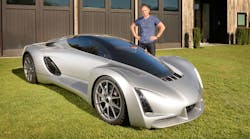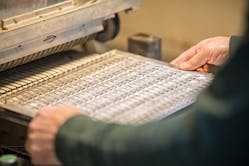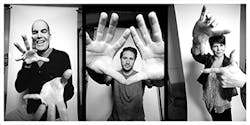“I know from very hard won experience that start-ups are enormously difficult and risky and chances are you’re not going to succeed,” says Kevin Czinger, the CEO of Divergent 3D, a company developing new technology for the automotive industry. “You’re always playing against the odds.”
Czinger’s “hard won experience” is based on co-founding CODA Automotive in 2009 to sell a new electric car. The company was only able to sell about 100 cars before it was forced to seek bankruptcy protection in 2013.
In 2015, some 20,000 new manufacturing companies were created in the United States. These innovators and dreamers provide an important source of the vitality of U.S. manufacturing.
Hit it big and you’ll be a legend (yes, Elon Musk, I’m thinking of you). But being an entrepreneur also comes with a healthy degree of risk. About half of new companies fail within five years.
We spoke with several manufacturing entrepreneurs about their careers, their newest ventures, and the joys and pitfalls of starting a new business.
Fixing a Broken Industry
Kevin Czinger looks at the heavy investment needed for traditional automobile production as the primary lesson of why CODA Automotive failed. Even using an existing automobile and assembling the car in China, he says, “We still spent more on the hard metal tooling of that vehicle than on all of our technology development.”
His new venture, Divergent 3D, based in Los Angeles, instead is focused on developing materials and joining techniques in order to produce cars on a modular basis that are much less expensive and have less impact on the environment.
Indeed, Czinger points to academic studies on lifecycle analysis of automotive manufacturing as a primary driver in his quest for more sustainable vehicle production. He says these analyses showed that when including not just tailpipe emissions but also the impact of manufacturing the vehicles and the fuels used to power them, and then the disposal of vehicles, the environmental impact of automobiles is much greater than previously thought.
“The part of the industry that is really broken is not drivetrains or vehicle infotainment or electronics. It’s how things are designed and manufactured and how we look at them from a lifecycle analysis,” says Czinger.
Czinger says his company will be able to disrupt current auto manufacturing methods because of the convergence of three technologies—computing power, standardized high-performance materials and 3D printing. Czinger explains that a designer can use software to design structures that are efficient and utilize low-cost materials such as are used in aerospace. Multiple materials, such as aluminum and carbon fiber, can be connected with patented nodes his team is developing that prevent galvanic deterioration. Additive manufacturing, he adds, lowers tooling costs dramatically and increases design flexibility and speed.
With these technologies, he says, auto manufacturers will be able to use modular assembly techniques to produce vehicles without investing in expensive stamping, body assembly and painting operations.
“All you’re left with is the assembly of modular structures that can scale up or down at low cost,” says Czinger.
Over the next couple of years, Czinger plans to work with carmakers and some non-automotive customers as well to develop and test the modular structures and then get a couple of vehicles into pre-production for testing and validation.
“We’ve got about 70-plus patents issued or filed or in process for the structures and the way that they’re manufactured and then assembled,” Czinger reports. “We’ll standardize that process, we’ll add more patents and then we’ll be able to license that process across the board as a manufacturing platform. So we are really a technology development and licensing company that will try to get that technology in the hands of as many manufacturers as possible.”
Vizinex Finds Its Niche
It was make or break time for Sandra Garby. She had worked for two manufacturing firms before starting a company of her own in 2001. That company made RFID tags but it was competing for retail customers against high-volume manufacturers based in Asia. She and her partners “learned a lot,” including that their firm wasn’t going to make it in that segment of the market.
While producing a significant stock of standard RFID tags, Vizinex can develop and produce tags for specific applications in as little as two weeks.
Now it was 2012 and she had the chance to start another RFID company.
“I was in my upper 40s so I kind of looked at it as this is my last chance,” she recalls. “If I’m going to go back to trying to work for a big company, I really didn’t want to be doing that in my mid-50s. I’ve got to make this decision - stick with my own business or go back into the corporate world now because I don’t think I can do it three or four or five years from now. I could but it would be a lot more difficult.”
Happily, Garby and her partners Bob Oberle and Ken Horton focused on a market niche that has proved very successful. Their company, Vizinex, produces RFID tags for tracking high-value assets, such as equipment like lighting and cables rented by motion picture companies. Garby serves as Vizinex’s president and vice president of operations.
“We design a tag for a specific application to optimize the performance and then we manufacture it and that is the targeted market that we’re going after,” she explained. Production can vary from as few as 1,000 tags to quantities approaching a million.
While Vizinex has a catalog of standard RFID products, it distinguishes itself by its ability to quickly modify and prototype optimized tags for specific applications.
Garby believes the industry grew “a little too fast early on” and customers didn’t fully understand the capabilities of RFID tags. It is not a plug-and-play scenario, she cautions.
“When we get a new customer, we work with the customer to understand their application, how they will be using it, explain some of the pitfalls they may run into, how to set up the reader and collect the data. That is all part of the services we offer,” she explains, adding that Vizinex’s expertise in RFID tag performance can “make the deployment go a lot smoother.”
Most of Vizinex’s competition is based offshore while Vizinex’s business is located in Allentown, Pa. Garby says closeness to customers and being in the same or adjacent time zone is a competitive advantage. “We’re a phone call away, a plane trip away,” she says, allowing the company to “respond very quickly to assist customers when they have questions.”
Vizinex RFID tags are manufactured by 10 employees in a 4,000-square-foot facility using surface mount technologies. Typically each tag will have one integrated circuit on it, though some will also have a capacitor. Along with this manufacturing, there is a service bureau operation where labels for the tag are produced to the customers’ specifications.
“We test every single tag that goes out our door. We test it to specification,” Garby notes. Since each lot is tested, she says, customers can be more confident that tags will perform more consistently from order to order.
Vizinex has grown anywhere from 25% to 40% annually since the company was founded. Garby is looking for a new facility that will increase space by 50%. That was one reason she recently hired an industrial engineer with experience in both mechanical and industrial engineering.
“I want her to be able to lay out my facility in a better fashion than I have now,” says Garby. “When we moved here, we were an awful lot smaller than we are now.”
While Garby was prepared for the hard work and long hours that a start-up requires, she says she didn’t fully appreciate at first how every decision the management team makes, from buying a piece of equipment to going after a new market, can potentially impact Vizinex’s employees and their livelihood. But having had to shut the doors on a business once, she now recognizes how “important to me” those considerations are.
Though shuttering her first company was painful, Garby says it offers an important life lesson for a younger generation that she worries has been too sheltered.
“If we don’t let our kids and young people fail, they are never going to learn and they’re never going to grow,” she says, adding, “I look at it as if you don’t fail at something, you’re not pushing yourself. You’re not trying new things. That’s what we have to be teaching young people.”
Putting Comunity on a Firm Footing
What motivates entrepreneurs to start a business? For veterans of corporate life like Sean and Shannon Scott and Ryan Gumienny, who had worked at companies such as Asics and Toms, it was the chance to take their corporate experiences in the footwear business, mix that with a strong social ethic to bring good jobs to Los Angeles and make a statement about the importance of U.S. manufacturing. That is the essence of how footwear company Comunity started.
“I believe very firmly that if you focus on people, on creating an empowered and impassioned work environment, that you create a more productive, innovative and in the end competitive—and if you want to say, profitable—work environment,” says Sean Scott.
Comunity co-founders Sean Scott, Ryan Gumienny and Shannon Scott are intent on using their company to provide jobs and resources for the local community
while helping to rebuild U.S. manufacturing.
Scott knew early on that he wasn’t cut out for corporate life. In the early ’90s, he had started a skateboarding shoe company called 2-Fish Shoe Works.
“Ultimately it didn’t succeed after three years but man, it was a really good, interesting three years. We did some really innovative stuff that I am still proud of,” he recalls.
Ten years later, Scott was back at it with Comunity. The partners used their own funds to begin the project, along with a Kickstarter campaign that not only provided additional funds but valuable marketing exposure.
Scott had originally planned to build a small shoe factory, but their experience was in sourcing in Asia and they wanted to manufacture in the U.S. They soon realized they needed to find a manufacturing partner.
“I can’t emphasize enough how hard it is to find good manufacturing in the United States,” Shannon Scott recalls.
Comunity shoes are hand-crafted
in a Los Angeles factory that has taken on the task of training local people to become shoemakers.
Gumienny, a shoe designer, took on the task of finding a manufacturing partner. The chances of finding a factory that could make shoes in the Los Angeles area was “slim to none,” he recalls. But after several months he located LaLaLand Production & Design, where its owner, Alex Czar, was interested not just in producing shoes but, notes Sean, in “manufacturing in the U.S. and how we can revitalize that.” It was exactly what the Scotts and Gumienny were interested in doing—encouraging manufacturers to return to the U.S.
It might seem that it would be much easier to manufacture in your own backyard than to deal with Asian suppliers. While the communication with the factory is much easier for Comunity, Gumienny notes that the company still has to deal with resource issues such as mold factories and material suppliers that simply don’t exist in the U.S.
In his previous jobs, Gumienny said it typically took 12 to 16 months from the time designers began working on a shoe to when it could get into customers’ hands. With their factory so close, he says, that time can be reduced to four to six months. That is important because Comunity is focused on producing a quality product and delivering it to customers at the time they want it.
The company’s mantra is, “Choose well and make it last.” Comments Sean Scott, “Fast fashion is great but sometimes inherent in that is an element of disposability which I am not a big fan of.”
Comunity’s strong social orientation is reflected in the workforce practices of LaLaLand. Its owner literally went into the streets to find workers and then train them in shoemaking.
Comunity gives $10 for each pair of shoes it sells to one of three charities it supports. It works with organizations such as Street Poets, a group that works with schools to help children find ways to express themselves through the arts, and Youth Mentoring Connection. They also support The People Concern, which helps the homeless.
“We really wanted to work with groups who offer a hand up, not just a handout,” says Shannon Scott. She said while the monetary support is needed, their greater goal is to get people involved with these community groups.
Comunity’s partners have been meeting with other businesses with similar objectives. Shannon Scott said there is a “really good spirit” in these businesses and it has been beneficial to bounce ideas off each other. She notes that while the company is focused on Los Angeles, it is interested in replicating its model in other urban areas.
Taking that message to other cities will likely require a good amount of pounding the pavements, but luckily, the Scotts and Gumienny make just the right product for the job. IW






